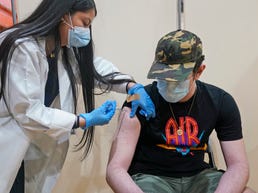
The pause on the Johnson & Johnson COVID-19 vaccine should be lifted, an expert advisory committee to the Centers for Disease Control and Prevention said Friday.
The recommendation by the CDC panel, called the Advisory Committee on Immunization Practices, has to be approved by the CDC and the Food and Drug Administration before becoming official government policy.
The pause, which began on April 13, was in response to reports of a rare combination of blood clots and low levels of platelets in people who had received the Johnson & Johnson vaccine.
The FDA and CDC will make a joint statement Friday evening about resuming use of the vaccine.
The advisory committee spent six hours Friday discussing how to handle the rare side effect.
"This is a serious adverse event. We need to continue to ensure that awareness is raised," said member Dr. Grace Lee, a pediatrician at the Lucile Packard Children’s Hospital and Stanford University School of Medicine, who supported the measure. "But I also think that we have to come out with a clear recommendation."
It shouldn't take more than a few days for the vaccine to become available again, said Dr. Henry Bernstein, a panel member and pediatrician at Cohen Children’s Medical Center in New Hyde Park, New York. But he said the break was important.
"I hope the pause draws the public's attention to the fact that the vaccine safety surveillance system works, that the vaccine's incredibly safe and effective, and it's immensely important for everyone to be vaccinated so we can put this pandemic behind us," Bernstein said.
CDC staff reported there have been 15 cases of the unusual disorder, among 7.89 million doses of the J&J vaccine delivered in the United States. All of the cases were in women, except for one man in the clinical trial.
The rare condition includes a combination of blood clots, many in unusual locations such as the brain or abdomen, and low levels of platelets, which help wounds heal. It has been dubbed thrombosis with thrombocytopenia syndrome or TTS.
The unusual side effect, seen six to 14 days after receiving the J&J vaccine, seems to most often strike women under age 50.
Similar unusual events were seen among British and European recipients of a different COVID-19 vaccine, made by AstraZeneca and Oxford University, which uses a similar delivery system as J&J's shots. The AstraZeneca-Oxford vaccine, which is not available in the United States, also seems to strike women more than men, though of a wider age range.
The effect has not been seen with the two other vaccines authorized for use in the U.S., by Pfizer-BioNTech and Moderna, which have so far been given to about 130 million Americans.
Resuming the use of the J&J vaccine in the United States would prevent 1,435 deaths from COVID-19 and 2,236 admissions to hospital intensive care units, according to a CDC analysis. It could cause approximately 24 cases of TTS, a CDC staffer said.
Three of the 15 known patients have died, roughly 20% of those diagnosed with TTS so far; an additional five people would be likely to die if use of the vaccine were resumed, according to a CDC analysis.
The J&J vaccine has been popular for some people because it only requires a single shot.
“Removing a vaccine that can be given as a single dose, which is a preference for Latinos in our community, would be a detriment,” said Dr. José Romero, chair of the committee and director of the Arkansas Department of Health.
The J&J shot has been especially popular for use in difficult-to-reach populations, such as people experiencing homelessness, the homebound, incarcerated individuals and college students.
“We really do depend on this 'one dose and you’re done' vaccine with easy storage” to reach at-risk populations, said Dr. Sandra Fryhofer, a professor of medicine at Emory University School of Medicine and liaison to the committee.
Women should be aware of this rare side effect, but if they're unlikely to come back for a second dose, then they're far better off getting the J&J than getting a single shot of Moderna or Pfizer-BioNTech, said Dr. Paul Offit, a pediatrician and head of the Vaccine Education Center at Children's Hospital of Philadelphia.
"If you're in a population where you're much less likely to get a second dose, then you clearly benefit from one dose of J&J's vaccine which induces the kind of cellular immune response that is not induced by the first dose" of the Moderna and Pfizer shots, he said after the meeting.
Americans also want to have some choice about which vaccine they receive, said Dr. Beth Bell, a committee member and professor of global health at the University of Washington.
“This is a time when we need options and flexibility,” she said.
The United States remains in the middle of a COVID-19 outbreak and so needs those options now, she noted. But recommendations could change as more information about the risks and benefits of vaccines becomes available.
Several panel members praised the CDC for recognizing and acting on the safety concern so quickly.
The FDA and the CDC first recommended the pause on April 13 after several reports of the unusual blood clotting condition showed up in the CDC's vaccine monitoring system.
Last Wednesday the advisory committee decided the pause should continue until at least Friday as the CDC gathered more information on the condition and more cases could potentially be identified. At that time, there were eight known cases of the condition.
It was very reassuring that so few additional cases have been identified since, said Dr. Grace Lee, a professor of pediatrics at Stanford University School of Medicine.
“The last 11 days for me have been reassuring in that we haven’t identified hundreds of more cases despite enhanced focus, which was my worry last week,” she said. “Last week I would have made a different decision than I would this week.”
TTS is so rare that the expert testifying before the CDC panel said he’d never seen it before.
Dr. Michael Streiff, a hematologist at the Johns Hopkins University School of Medicine, said it occurred in about 1 out of 100,000-250,000 recipients of either the J&J or AstraZeneca-Oxford vaccines.
Thrombocytopenia occurs when someone has fewer than 150,000 platelets, also known as thrombocytes, per microliter of blood. Dangerous internal bleeding can occur with platelet counts below 10,000, a figure reached by many of the patients with TTS. Such severe thrombocytopenia can cause fatal bleeding into the brain.
Most of the blood clots, also called thromboses, occurred in the brain, though several were in the abdomen.
Public health officials have warned that anyone who develops a severe headache or leg or abdominal pain a week or two after vaccination with the J&J vaccine should seek immediate attention.
This side effect is different from initial reactions to a vaccine, which start a day or two after a shot and are short-lasting.
Streiff also recommended that these patients not be given heparin, a drug commonly used to combat blood clots, as it may exacerbate symptoms. None of the three TTS patients who died received heparin, but six were given the drug before the pause.
Overall, the committee decided the benefits of the J&J vaccine still outweigh the chance of this very rare side effect.
COVID-19 itself causes 200 people to be hospitalized and leads to 30 deaths out of every million Americans, CDC numbers show, compared to 15 hospitalizations and three deaths out of more than 7 million who received the J&J vaccine.
“The overwhelming risk benefit here is ‘Get the vaccine you can get,’” said Dr. Robert Gluckman, chief medical officer of Providence Health Plans, a health network in Oregon.
Contact Elizabeth Weise at [email protected] and Karen Weintraub at kweintraub@usatoday.
Health and patient safety coverage at USA TODAY is made possible in part by a grant from the Masimo Foundation for Ethics, Innovation and Competition in Healthcare. The Masimo Foundation does not provide editorial input.

Source link








